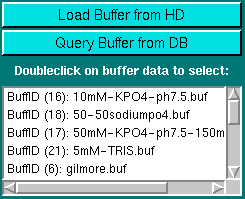

|
Manual |

To correct sedimentation and diffusion coefficients, as well as molecular weight, to standard conditions of water at 20 oC, use the buffer correction utility of UltraScan.
Note: This program will utilize the database backend of UltraScan. This functionality allows you to save certain files and data in a database, among them the nucleotide files analyzed with this module. If the database system is not supported or available on your system, you will get a warning message when opening this module.
This utility can be accessed in one of three ways:
When using the second option, the temperature of the experiment will
automatically be used to correct the density and viscosity of the selected
components to the temperature of the experiment.
Explanation of fields and buttons:

|
Buffer File Loading: You can load buffer definition files into this program by one of two methods:
|

|
|

|
|
 
|
In order to select an item from the list on the left, simply highlight the buffer component and enter the concentration in the units shown above the concentration entry field. Add this component to the buffer by hitting the enter key. You can repeat this procedure for each component to be added to the buffer. To deselect a component and remove it from the list, double-click on the item. Please note: There are different concentration units for various buffer components. Please verify the appropriate unit before entering the concentration. |
This document is part of the UltraScan Software Documentation
distribution.
Copyright © notice.
The latest version of this document can always be found at:
Last modified on January 12, 2003.